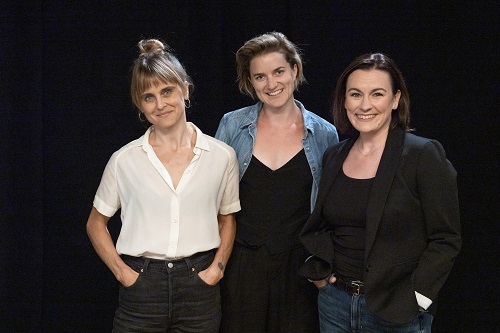In Germany, wedding guests smash piles of crockery the night before the ceremony, the custom of Polterabend being thought to bring good fortune to the bride and groom in their married life. In Scotland, to ward off evil spirits grooms and brides-to-be are subjected to a ritual known as ‘blackening’ that involves them being covered in a mixture of treacle, soot, feathers and flour and noisily paraded through the streets. On wedding-eves in Czechoslovakia, close female friends and family plant a tree in the bride’s garden and decorate it with coloured ribbons and eggshells, while in China a legend about a Zhao princess who broke down in tears at her wedding has led to the custom of ‘crying preparation’ which sees first the bride, then her mother and grandmother, and finally every female family member joining in a cacophony of weeping on the night before the big day.
Wedding rituals are myriad and multifarious. The Montreal-domiciled Serbian composer Ana Sokolović explored such customs in her 2011 opera, Svadba, which, during on Balkan folk tales and myths, dramatises the eve-of-ceremony gathering of a bride-to-be, an elder female relative and four close friends, as they undertake the traditional rituals that emphasise the importance of friendship, continuity and community as the bride prepares to begin a new stage in her life. The opera is sung in Serbian by six female a cappella singers who enact the ceremonial preparations and reflect on the impending union. Widely performed across the world during the last decade, Svadba has now been re-interpreted by film director Shura Baryshnikov and screenwriter Hannah Shepard in a new dance-led film produced by Boston Lyric Opera (BLO) and co-produced with Opera Philadelphia, with Slovenia-born Daniela Candillari conducting.

In this new cinematic interpretation, six dancers and actors enact the celebratory rituals that the bride-to-be Milica, maid-of-honour Ljubica, and bridesmaids Danica, Nada and Zora carry out, as guided by the family elder Lena. They gather in the morning at Lena’s ocean-side home and pick flowers, make food, weave headdresses, dance and drink, decorate the bridal gown, dye Milica’s hair and bathe her in perfumed water, the gravity of their careful rituals occasionally interrupted by moments of both carefree joy and sombre reflection.
The moon keeps watch as day passes into night; the sounds of dawn awaken Milica from her slumber on the golden sand. The swish of the waves and whistle of the breeze, the fragile beauty of the shore-side reeds and rosehips, and the expanse of strand, sea and sky cohere to create a sense of freshness and freedom, but also suggest the significance of the coming rite and Milica’s youthful vulnerability. The terrace which separates the house from the beach, the sandy path that slopes to the sea, and the shifting shoreline itself all hint at the figurative threshold that Milica is soon to cross.

The narrative is intercut with shots of the six singers who, dressed in black and standing in a circle, seem to embody the collective voice of tradition, watching over the unfolding action. The singing is a virtuoso tour-de-force. Drawing on her native Balkan folk music, Sokolović requires the singers to employ diverse idioms and tones ranging from conventional classical techniques to folk overtones, extreme chest voices and delicate whispers, onomatopoeic sounds and phonemes. At times, the voices interlock in coloristic rhythmic patterns of whoops, trills and clicks. Passages of unison and homophony, and repeating nursery rhymes and word games, emphasise the collectivity of the expression. Elsewhere, individual voices break away in extended melodic explorations. The changing idioms and rhythmic structures have their own momentum and ‘rightness’. The sound really is the ‘sense’.

Occasionally, reflections and dreams slip into fantasy. As Milica gazes in a hand mirror while the others dress her hair and paint her with henna, we slip – like Alice through the looking-glass – into her inner imaginings which are made tangible through dance and colour. As the ceremony approaches, there is a growing intensity, both visual and vocal. One can almost smells the petals floating in Milica’s hammam bath, as an extended lyrical vocal solo unfolds. As it is gradually embraced within the accumulating harmonies, the ensemble ever more rich of timbre as the dynamic and pitch rise, the dancers join hands to form an unbreakable circle.
Svadba communicates directly, emotionally and viscerally, fusing movement and music; speech and song; image, sound and silence; happiness and sadness.
Svadba is available to view on BLO’s operabox.tv and the Opera Philadelphia Channel from 28th January 2022.
Claire Seymour
Svadba, by Ana Sokolović
Dancers/Actors: Milica – Victoria L. Awkward, Lena – Jackie Davis, Danica/attendant – Jay Breen, Zora/attendant – Sarah Pacheco, Nada/attendant – Emily Jerant-Hendrickson, Ljubica, the maid of honour – Sasha Peterson, The Betrothed – Olivia Moon.
Singers: Milica – Chabrelle D. Williams, Lena – Brianna J. Robinson, Danica – Maggie Finnegan, Zora – Mack Wolz, Nada – Vera Savage, Ljubica – Hannah Ludwig as Ljubica
Director – Shura Baryshnikov, Conductor – Daniela Candillari, Screenwriter – Hannah Shepard, Production Designer – Ana Novacic, Director of Photography – Katherine Castro, Costume Designer – Lena Borovci.